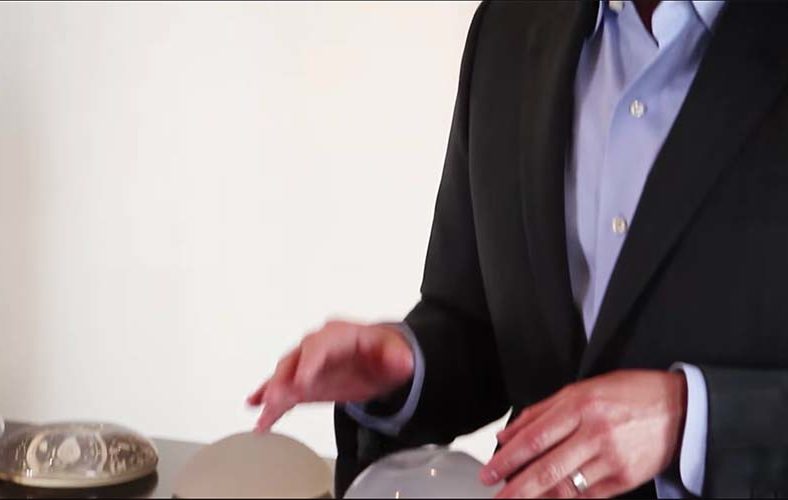
Breast Implants in santa barbara, ca
Breast Implants — Your Options
To enhance breast size and shape or to reconstruct breasts after a mastectomy, plastic surgeons often use implants. These medical devices, which have been around since the 1960s, are the mainstay of breast augmentation surgery. Technology has advanced since those times, and today’s patients have a wide range of breast implant types and profiles to choose from.
At Montecito Plastic Surgery in Santa Barbara, Dr. Lowenstein offers a number of implants to his patients. The choice of implant depends on patient preference and what you want to achieve with breast augmentation surgery. Our biggest priority is patient safety; all of the implant choices we offer are FDA cleared and considered safe after extensive clinical research.



Implant Texture
Silicone and saline implants can have a textured outer surface instead of smooth. The textured exterior prevents them from moving inside the breast, which is helpful in some cases. The textured surface also helps reduce the risk of capsular contracture. However, there are concerns that these implants increase the risk of some forms of cancer.
You can read more about breast implants and cancer risk here
Types of Breast Implants
Saline Implants
Saline implants were first introduced in the mid-1960s and have not changed much since. They have a silicone shell filled with sterile saltwater — the same type used in IV infusions. The implants used at Montecito Plastic Surgery are inserted empty and then filled with the saline solution. There are several advantages to saline implants: your body will safely absorb the saline in case of a rupture, you can detect ruptures quickly and the implants can be inserted with a small incision.
Their downsides are that they may look and feel less natural than silicone gel implants. There are also concerns saline implants can become contaminated with bacteria and fungus, which some worry may result in systemic disease. This may have been an issue in the past, but novel techniques prevent the saline from coming into contact with contaminants.
Round Silicone Implants
Round silicone implants are the mainstay of breast augmentation surgery. They are dome-shaped and have an outer silicone shell filled with silicone gel instead of saline. New silicone implants are filled with a cohesive gel of silicone rather than the liquid silicone that was prevalent in years past. The term “gummy” was coined with the increasing crosslinking of the silicone molecules in the gel, which can be adjusted to create softer or firmer consistency. Most of Dr. Lowenstien’s patients prefer the natural feel of moderate crosslinking silicone gel.
Many women choose these implants because they behave and feel the most like natural breast tissue. They are soft to the touch and have enough movement to help create any type of cleavage. Their main disadvantage is the risk of “silent ruptures.” Because your body cannot absorb silicone, and because silicone implants do not always deflate with ruptures, you may not notice anything is wrong if an implant ruptures. That is why women with these implants need to undergo regular MRIs to see if their implants are intact.
Shaped Silicone Implants
Shaped silicone implants are teardrop-shaped and ideal for women who are having breast reconstruction. They are also known for their slightly firmer feel compared to traditional silicone implants. If you prefer to have firmer breasts and do not mind reduced movement, then these might be your ideal choice. One of their chief advantages is that they can slightly lift the breasts in women with mild drooping. Shaped implants also come with a lower risk of ruptures and capsular contracture compared to other implants.
The IDEAL IMPLANT®
As the name suggests, the IDEAL IMPLANT® blends the best qualities of all the other implants, creating an ideal middle ground. Specifically, the product attempts to provide the look and feel of gel implants with the lower maintenance of saline. No MRI is required with these implants to monitor for silent rupture.
Also known as the Structured Implant, the IDEAL IMPLANT® is composed of a series of shells nested together, with two chambers containing saline. This unique structure controls movement of the saline, helping the implant maintain its shape. The design also minimizes the risk of ruptures and results in a natural feel.

Implant Size and Profile
All implants come in different sizes and profiles. The size of implants can range from 150 to 800 ccs (cubic centimeters, which is the same as milliliters). The implant profile determines how much “projection” you will have. There are three implant profiles: low, moderate and high. Low profiles are relatively flat and give minimal projection, while high profiles provide maximum projection. Dr. Lowenstein will explain which profile is best for your body type.

Schedule A
Consultation
Schedule Now
FAQs
What kind of breast implant is best?
There is no one breast implant that is better than the others; it all comes down to personal choice. The best breast implant is the one that can help you achieve the look and feel you are after while also taking into account your unique needs and concerns.
How do I choose the right breast implant?
Dr. Lowenstein can help you decide which breast implant is ideal for your particular physique and case. He will explain the risks and benefits of each implant type so that you can come to an informed decision. He may suggest some implants over others after carefully evaluating your goals, history and concerns.
Will I be able to feel the breast implant?
Appropriately sized and positioned implants should feel almost like your natural breasts. However, you may be able to feel your implants more if you enhance your breasts by several cup sizes. If you develop capsular contracture, which is the hardening of scar tissue around the implant, your breasts may feel hard and unnatural. In that case, you will probably need to undergo an implant revision. Capsular contracture is a rare occurrence in Dr. Lowenstein’s practice due to his meticulous technique.
Is breast implant rupture an emergency?
Not necessarily. A breast implant rupture is unlikely to cause serious health problems. If you have a saline implant rupture, it is still important to have your implant replaced as soon as possible to reduce pocket collapse. It is easier to tell when an implant has collapsed with saline implants than with silicone ones. That is why the FDA recommends regular MRI screening to women with silicone implants but not those who have saline ones. Dr. Lowenstein recommends getting implant revision surgery within three weeks following a saline rupture. Silicone implants don’t get smaller when they rupture as saline implants do, and so there is rarely collapse of the breast tissue around a ruptured silicone implant. Leaving a ruptured silicone implant in place for a few weeks to months is usually not problematic, but the longer a ruptured silicone implant is left in the body, the more likely capsular contracture is to occur.
Will I be able to breastfeed after getting breast implants?
The answer is usually yes. Breast implants are placed between your chest wall and your breast tissue. In this way, they cannot interfere with milk ducts or mammary glands. Surgeons may sometimes remove a little bit of glandular tissue (tissue that produces milk), which may reduce your milk production only slightly. When an incision is made around the nipple, this too can affect how much milk you are able to produce. This is one of the reasons why Dr. Lowenstein suggests a lower breast incision in the crease below the breast. But all in all, most women who have implants can breastfeed without any trouble.
Is breast implant illness real?
Breast implant illness (BII) is not officially recognized as a medical diagnosis. To date, there have been no studies examining women who have developed what is called BII. But that does not necessarily mean it does not exist — it is just poorly understood at the moment. BII refers to symptoms some women experience following breast augmentation. These symptoms are fairly unspecific and wide-ranging. Some patients develop symptoms soon after surgery, while others develop them later.
Recent studies suggest that the symptoms associated with BII would likely occur with or without a history of breast implant placement. Should a patient develop vague or unexplained symptoms following breast implant placement, they may choose to have their implants removed to ensure that the breast implants are unrelated to their condition.

